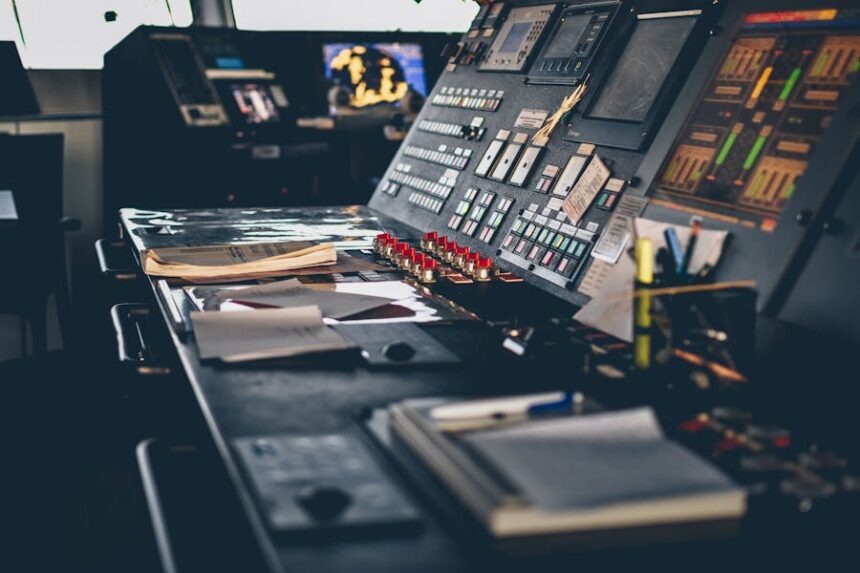Significant technological breakthroughs across various industries have revolutionized control room operations and significantly enhanced productivity and safety. These changes have been drastic but necessary to reduce workload and ensure that operations move faster and with more accuracy. Now, they rely upon automation, digitization and data analysis to streamline processes, inspiring a new era of control room operations.
This article will answer the very important question, “What is a control room?”. We would also review changes that have taken place and their effect on different sectors.
What is a Control Room?
Control rooms are focal points in key sectors, such as manufacturing, telecommunications, oil and gas and power generation. This is a company’s helm of affairs where all decisions are made. Once equipped with manual switches and analog gauges, these areas now boast advanced data integration and automation.
Control Room Improvement in Common Sectors
The application of various improvements in the technology of control rooms may vary from sector to sector. Let us take a look at some of these industries and how they have been affected by control room advancement.
Oil and Gas Industry
In the past, drilling operations were carried out using physical controls and analog systems. That is not the case today; all operation personnel do not have to be on-site to ensure a smooth process.
Coordinating real-time data with remote monitoring has enhanced worker safety and reduced downtime in control rooms. Even today, immersive displays and digital AI-led systems are detecting anomalies before they cause a catastrophic event.
Power Generation & Utilities
Thanks to smart grid and AI analytics, operators can quickly find where errors occur. This improvement provides a more precise balancing of electrical loads, improves the reliability of the power system and lessens blackouts.
Manufacturing
With the introduction of sensors in manufacturing companies, control rooms also started to grow and get automated.
Packaging and weighing are now semi-automatically, and machines pack and weigh the products.
Railways and Airports
Tracking systems and predictive analytics are used in rail and aviation control rooms to anticipate delays and optimize routes. Real-time traffic management systems help promote quicker reaction times to weather-related incidents and accidents that could impede traffic flow.
Hospitals
Automatic sensors track patient vitals in hospital ICUs and operating rooms, and AI assists with diagnostics. A prime example is the digital sphygmomanometer, which measures blood pressure as opposed to the manual method. Data from several hospitals can be accessed in control rooms, promoting centralized patient monitoring with quicker emergency response.
Defence and Military
Cyber defense tactics, sophisticated simulations, real-time threat analysis, and drone technology are some of the improvements in the military sector. These have led to quicker and more accurate reactions to military threats in the tactical domain.
Banking and Finance
Financial organizations can use a single control room to monitor risks and oversee huge transactions and data analytics. They can accomplish this by using additional sophisticated security procedures and fraud detection algorithms.
Telecommunications
Currently, telecommunication companies also have automatic systems that can analyze and fix errors, resulting in less service disruption.
The invention of 5G networks, performance analysis, and cloud-based network operation centers has greatly enhanced network monitoring processes.
Impact of Major Advancements in Control Rooms
| Technological Advancements | Description | Impact |
| Analogue to Digital | The switch from analog systems to digital was achieved by integrating real-time data acquisition and monitoring. | It has a broader vision regarding business visibility and preemptive maintenance. |
| Automation and Robotics | Automated distribution, monitoring, inspection, and decision processes in control rooms. | Tasks can be carried out remotely in production areas that involve very high risk. |
| Data Analytics and AI | AI algorithms and advanced analytics are used for predictive maintenance and anomaly detection. | Improved decision-making and proactive maintenance strategies, which reduce operational costs. |
| Virtual Reality | The advent of virtual reality improved consumer relatability and situational awareness. Consumer needs can be foreseen and met before they arise. | It lessens the cognitive load and improves reaction time to critical situations. |
| Cybersecurity Measures | Cybersecurity protocols protect control rooms from cyber threats and data manipulation in operational security. | There is a reduction in risks from data breaches and unauthorized access. |
Final thoughts from us
Thanks to these improvements in control room technology, our daily lives have been made easier. We now do things from the comfort of our homes, like making calls to loved ones and business associates.
Control room technology is yet to witness even more advancements as discoveries are made in science every day.




